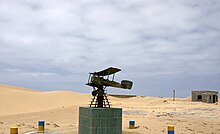Cape Juby

Cape Juby (Arabic: رأس جوبي, trans. Raʾs Juby, Spanish: Cabo Juby) is a cape on the coast of southern Morocco, near the border with Western Sahara, directly east of the Canary Islands.

Its surrounding area, including the cities of Tarfaya and Tan-Tan, is called the Cape Juby Strip (after the homonymous cape), the Tarfaya Strip (after the homonymous city) or the Tekna Zone (after the Tekna, the native Saharawi tribe). The region is presently the far south of internationally recognized Morocco, and makes up a semi-desert buffer zone between Morocco proper at the Draa River and Western Sahara. The strip was under Spanish rule during much of the 20th century, officially as part of the Spanish protectorate in Morocco, but mainly administered alongside Saguía el-Hamra and Río de Oro as part of Spanish Sahara, with which the Strip had closer cultural and historical links.
History
Precolonial era
On 28 May 1767, Mohammed ben Abdallah, the Sultan of Morocco, signed a peace and commerce treaty with King Charles III of Spain. In the treaty, Morocco was unable to guarantee the security of Spanish fishermen along the coasts south of the Noun River, as Morocco did not have control over the Tekna tribes of that area (Art. 18).[1][2][3]
On 1 March 1799, Sultan Slimane signed an accord with King Charles IV of Spain, in which he recognized that the Saguia el Hamra and Cape Juby regions were not part of his dominions (Art. 22).[2][3]
In 1879, the British North West Africa Company established a trading post near Cape Juby called "Port Victoria". On 26 March 1888, Moroccan soldiers attacked the post, killing the director of the post and leaving two workers badly injured.[4] In 1895, the company sold its post to the Sultan of Morocco.
Spanish protectorate

In 1912, Spain negotiated with France (which controlled the affairs of Morocco at the time) for concessions on the southern coast of Morocco.[citation needed] Francisco Bens officially occupied the Cape Juby region for Spain on 29 July 1916. It was administered by Spain as a single entity with Spanish Sahara and the Ifni enclave, as Spanish West Africa.
The Spanish area comprised 12,700 sq mi (33,000 km2) and had a population of 9,836.[citation needed] Its main town was founded by the Spanish as Villa Bens (now called Tarfaya). Villa Bens was used as a staging post for airmail flights.
Retrocession to Morocco
When Morocco regained full independence in 1956, it requested the cession of officially Moroccan areas controlled by Spain. After some resistance and some fighting during 1957 (the Ifni War), the Spanish government in 1958 ceded the Cape Juby Strip to Morocco.
Sahara sea
In 1877, the Scottish engineer Donald Mackenzie was the first to propose the creation of a Sahara Sea. Mackenzie's idea was to cut a channel from one of the sand-barred lagoons north of Cape Juby south to a large plain which Arab traders had identified to him as El Djouf.[5][6] Mackenzie believed this vast region was up to 61 metres (200 ft) below sea level and that flooding it would create an inland sea of 155,400 square kilometres (60,000 sq mi) suited to commercial navigation and even agriculture. He further believed that geological evidence suggested this basin had once been connected to the Atlantic via a channel near the Saguia el-Hamra. He proposed that this inland sea, if augmented with a canal, could provide access to the Niger River and the markets and rich resources of West Africa.[6] There are several small depressions in the vicinity of Cape Juby; at 55 m (180 ft) below sea level, the Sebkha Tah[7][circular reference] is the lowest and largest. But it covers less than 250 km2 (97 sq mi) and is 500 km (310 mi) north of the geographical area identified as El Djouf (also known as the Majabat al-Koubra[8]) which has an average elevation of 320 m. Mackenzie never travelled in this area but had read of other sub-sea level desert basins in present-day Tunisia, Algeria and Egypt similar to those found near Cape Juby.[6] These basins contain seasonally dry salt lakes, known as chotts or sebkhas. Egypt's Qattara Depression is perhaps the largest such basin in North Africa.
See also
- Postage stamps and postal history of Cape Juby
- Santa Cruz de la Mar Pequeña
- Tekna
- Ifni War
- Sahrawi
- Reguibat
- Western Sahara
- Morocco
- Sahara Sea
- Cape Bojador
- Qattara Depression
References
- ^ "Tratado de Paz y Comercio entre España y Marruecos firmado el 28 de mayo de 1767". PARES. Retrieved October 11, 2021.
- ^ a b Pedro Giménez de Aragón Sierra. "Proyecto Ibn Jaldun. VII. El colonialismo español en el s. XIX: África. 2. Chafarinas, Sidi Ifni y el Sáhara" (in Spanish). Junta de Andalucía. Retrieved June 15, 2010.
- ^ a b Cesáreo Fernández Duro (September 8, 1877). "Cautivos españoles en Cabo Blanco" (PDF) (in Spanish). La Ilustración Española y Americana nº XXXIII. p. 156. Archived from the original (PDF) on August 14, 2011. Retrieved June 16, 2010.
- ^ José Fernández Bromón (May 15, 1888). "Sucesos de Marruecos" (PDF) (in Spanish). La Ilustración Española y Americana nº XVIII. p. 307. Archived from the original (PDF) on August 14, 2011. Retrieved July 23, 2010.
- ^ Cust, R. (1884). "The railway over the Sahára from Algeria to the Senegál and the destruction of Colonel Flatters". Journal of the Royal United Service Institution. 28 (77). Royal United Services Institute for Defence Studies: 839–856. doi:10.1080/03071848409424351. Retrieved December 18, 2012.
- ^ a b c Mackenzie, Donald (1877). The flooding of the Sahara: an account of the proposed plan for opening Central Africa to commerce and civilization from the north-west coast, with a description of Soudan and western Sahara, and notes of ancient manuscripts, &c. London: Sampson Low, Marston, Searle, & Rivington. Retrieved December 18, 2012.
- ^ fr:Sebkha Tah
- ^ "El Djouf desert, Mauritania". mr.geoview.info.
